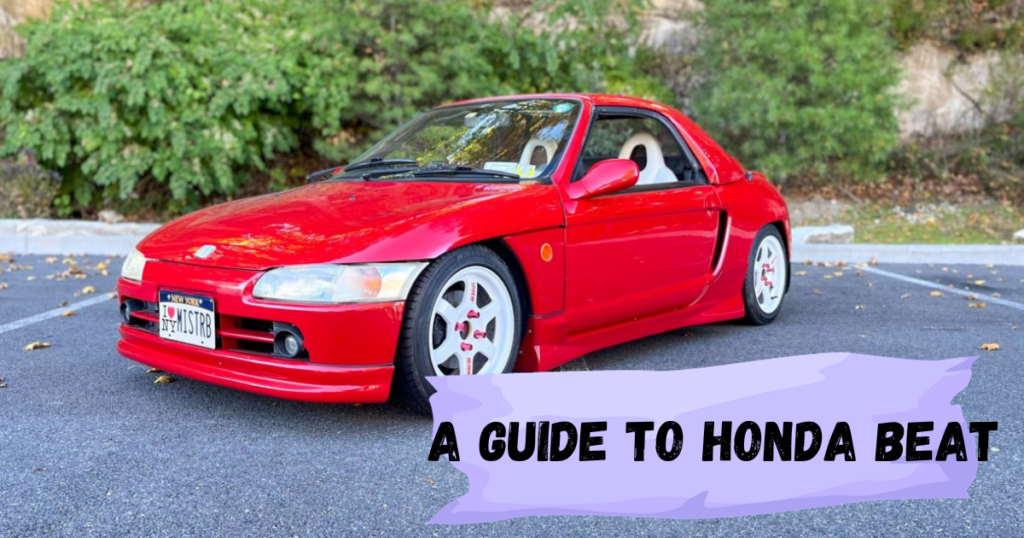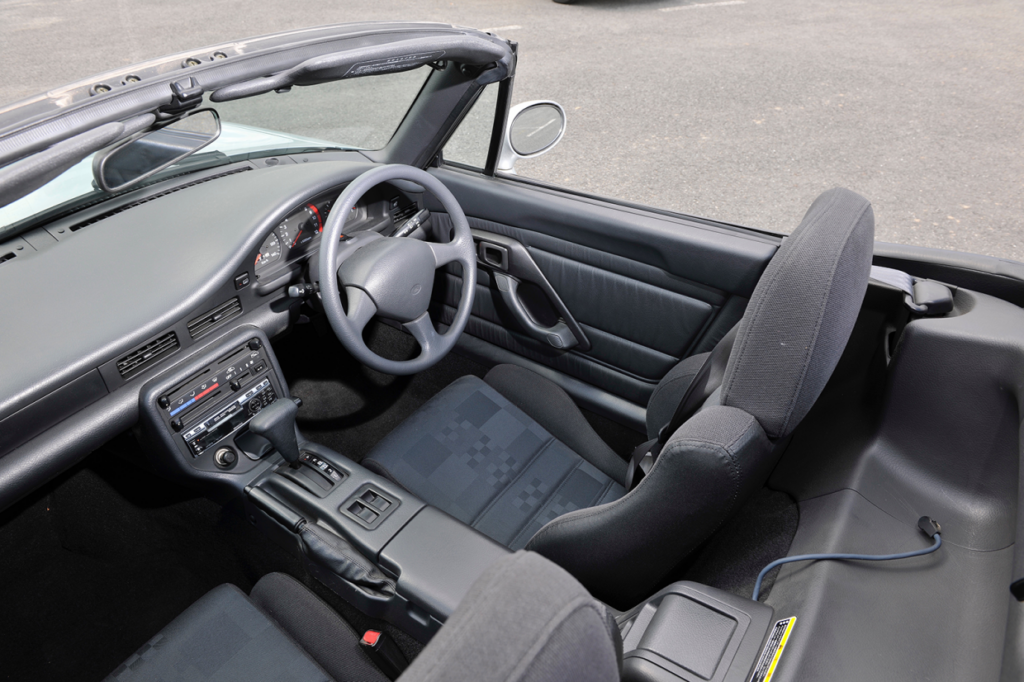
The Honda Beat is a driving pleasure par excellence when it comes to small, thrilling cars. Since its launch, this little powerhouse has captured the attention of car enthusiasts with its exceptional combination of performance, style, and pure joy when driving.
With its elegant look and carefully crafted specifications beneath the engine, the Honda Beat is a tribute to Honda’s dedication to creating automobiles that elevate the driving experience. As we explore this powerful roadster’s features, prepare for an exciting journey.
Why Honda Beat?
The Japanese call the Honda Beat a “Kei car” or “keijidosha,” which translates to “light automobile.” Because of the small size and limited number of roads in Japan, kei cars were created in 1949 as the smallest street-legal automobiles in that nation. Because the 660cc engine displacement and low power output are the only options available to Kei owners, they can save money on insurance and taxes.
On the surface, it does not seem very interesting that the majority of these vehicles are modest trucks and vans with unimpressive powertrains. However, a few companies, such as Honda, have produced oddball sports cars in the Kei vehicle class over the years.
Among these sports cars is the Beat, which has a three-cylinder engine that can rev high and is arranged in a mid-engine configuration. You will have a great time operating the Beat if you are a fan of the Mazda Miata. It’s also uncommon to see one in the US, so you’re sure to draw interest at regional auto shows.
Chassis and Suspension

The Honda Beat’s sturdy steel monocoque chassis, which has an 89.76 in (2280 mm) wheelbase, serves as the cornerstone for its explosive performance. Both ends use a small, fully independent MacPherson strut suspension with coil springs, and the front has an anti-roll bar. The braking system is made up of 8.38 in (213 mm) front and 9.37 in (238 mm) rear solid, unventilated discs, with ABS only available on the flagship PP1-110 model.
Wheels and Fuel Configuration
The Beat is equipped with steel 10-hole pepperpot rims, the front wheels measuring 13 x 4.5 in (330.2 x 114.3 mm) and the rear wheels measuring 14 x 5 in (355.6 x 127 mm). The power unit is purposefully shifted to the left to make room for the 24-liter gasoline tank located on the right side of the engine bay.
Engine and Transmission

The Beat’s transversely-mounted, water-cooled, all-alloy inline three-cylinder engine shows Honda’s engineering skill. With four valves per cylinder, a drive-by-wire throttle, and a single overhead camshaft, the Type E07A motor produces an impressive 96 horsepower per liter without the need for forced induction.
A Multi Throttle Responsive Engine Control system (MTREC) with separate throttle bodies for each cylinder is used by this free-revving engine. With Honda’s PGM fuel injection, the 656cc engine achieves a 10.0:1 compression ratio.
Body Design
Honda hired the renowned Pininfarina design studio in Turin to assist with styling the Beat. Pininfarina, in turn, subcontracted the work to Pavel Husek, a freelance stylist. The Beat had extremely short overhangs to allow for the lengthy wheelbase while still measuring less than 3.3 m (129.9 in) overall.
Unique single-piece halogen lighting on the front end swept over to the wheelchairs. Air was supplied to the front-mounted radiators via full-width intakes. A thin vertical duct that assisted in cooling the engine was located behind each door. The engine compartment was completely sealed, except for two banks of vents that were removed from the rear bumper.
The sills were left in satin black to give the Beat a narrow silhouette. Black finishing was also used on the windscreen surround. A manually operated canvas roof folded mostly out of sight when retracted, but it was still easy to raise and lower. As an alternative, a cover was included to help hide the mechanism.
Interior Features
The upholstery was a combination of fabric and hard plastics in the interior. There has never been a zebra print pattern like the one on the Beat’s floor mats, center console pad, or seats.
Electric windows and air conditioning were standard. A sizable rev counter was located behind the three-spoke, non-airbag steering wheel. There was a somewhat smaller speedometer over to the right. While the combined fuel and water temperature gauge off to the left had a black face, the other two indicators had white faces and red markings.

Two air vents, the air conditioning controls, a hazard alert button, and a storage tray were all located on the central control panel. On the transmission tunnel, the electric window switches were installed next to the gear lever. Except for the rather small headroom for tall drivers, the Beat’s cockpit was pleasantly roomy.
But the spare wheel took up room behind the front lid, so there was nowhere to put luggage. Rather, the passengers were forced to settle for a tiny trunk located behind the engine.
Performance and Weight
With a weight distribution of 43/57 and a mere 760 kg (1675.51 lb), the Beat strikes the ideal mix between stability and agility. Domestic restrictions require an electronically limited top speed of 83 mph (133.57 kph). However, the unrestricted version can reach up to around 100 mph (160.93 kph).
The Beat is a pleasure to drive thanks to its rev-happy engine and go-kart-like handling, but its performance stats—which include a 0-62mph (0-99.77 kph) time of 13 seconds—only tell part of the story.
Space and Efficiency

Even by Japanese standards, this is a little car, so there’s not a lot of space for storage. It tends to get hot back there, so go light. There isn’t much storage room inside, and the engine shares the rear trunk. Positively, even by today’s standards, the small engine is fairly efficient, achieving about 40 mpg.
Special Editions and End of Production
In 1992, Honda released Version F and Version C, then in 1993, Version Z, as special editions to increase demand. 33,635 vehicles, all in right-hand drive, were made before the Beat’s production stopped in February 1996. Sales eventually decreased despite its early success, and the Honda S660 replaced it in 2015.
The Cost
We advise working with a reputable importer because importing an automobile from Japan is complicated. The fee is justified since it saves you from managing the paperwork involved in importing a JDM vehicle into the US, even though these shops charge more to do it all.
The Honda Beat is a basic Kei car, so even after accounting for importation fees, you may still get one for a low price. We looked through a few importer websites and discovered that costs ranged from about $13,000 for a perfect automobile to about $5,000 for high-mileage specimens.
FAQs
What is the production period of the Honda Beat and who was involved in the design of the Honda Beat?
The Honda Beat was manufactured from May 1991 to February 1996. The original car design was a collaboration between Pininfarina and freelance stylist Pavel Husek.
How many Honda Beat units were produced in total? Are there special editions of the Honda Beat?
Approximately 33,600 Honda Beat units were manufactured. Special editions such as Version F, C, and Z were produced between 1992 and 1993.
What is the engine configuration of the Honda Beat?
The Honda Beat features a transversely-mounted, water-cooled, all-alloy inline-three engine.
How much does the Honda Beat weigh, and what is the top speed of the Honda Beat?
The Honda Beat weighs approximately 760 kg (1675.51 lb). The top speed is electronically limited to 83 mph (133.57 kph) per domestic regulations.
Conclusion
The Honda Beat ought to be at the top of your list of vehicles to consider if you’re looking for a sports car that’s unlike anything else on the road but yet wants to keep costs down. Even though the automobile has many problems, such as low power and storage capacity, we urge you to test drive it and enjoy its enjoyment.




